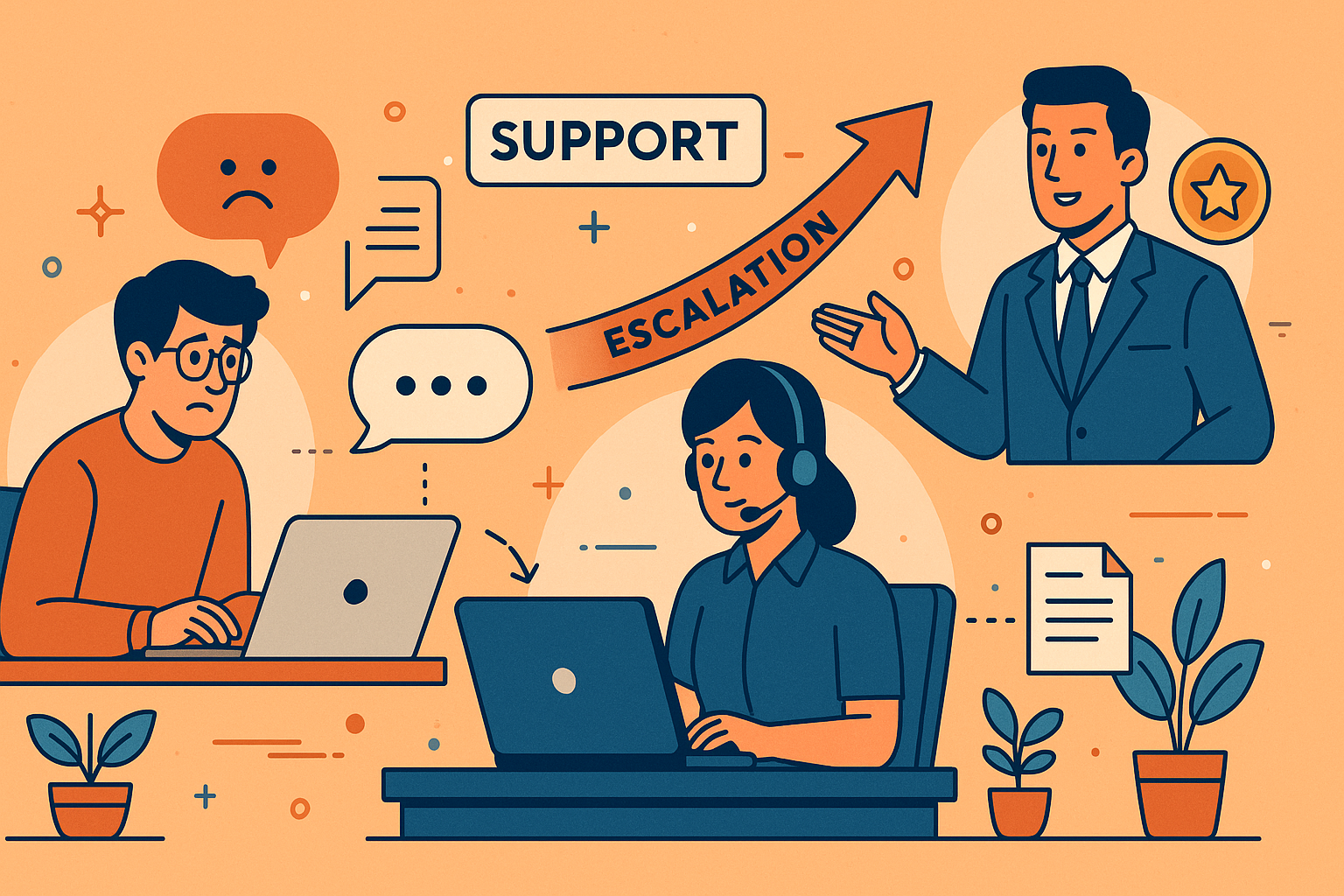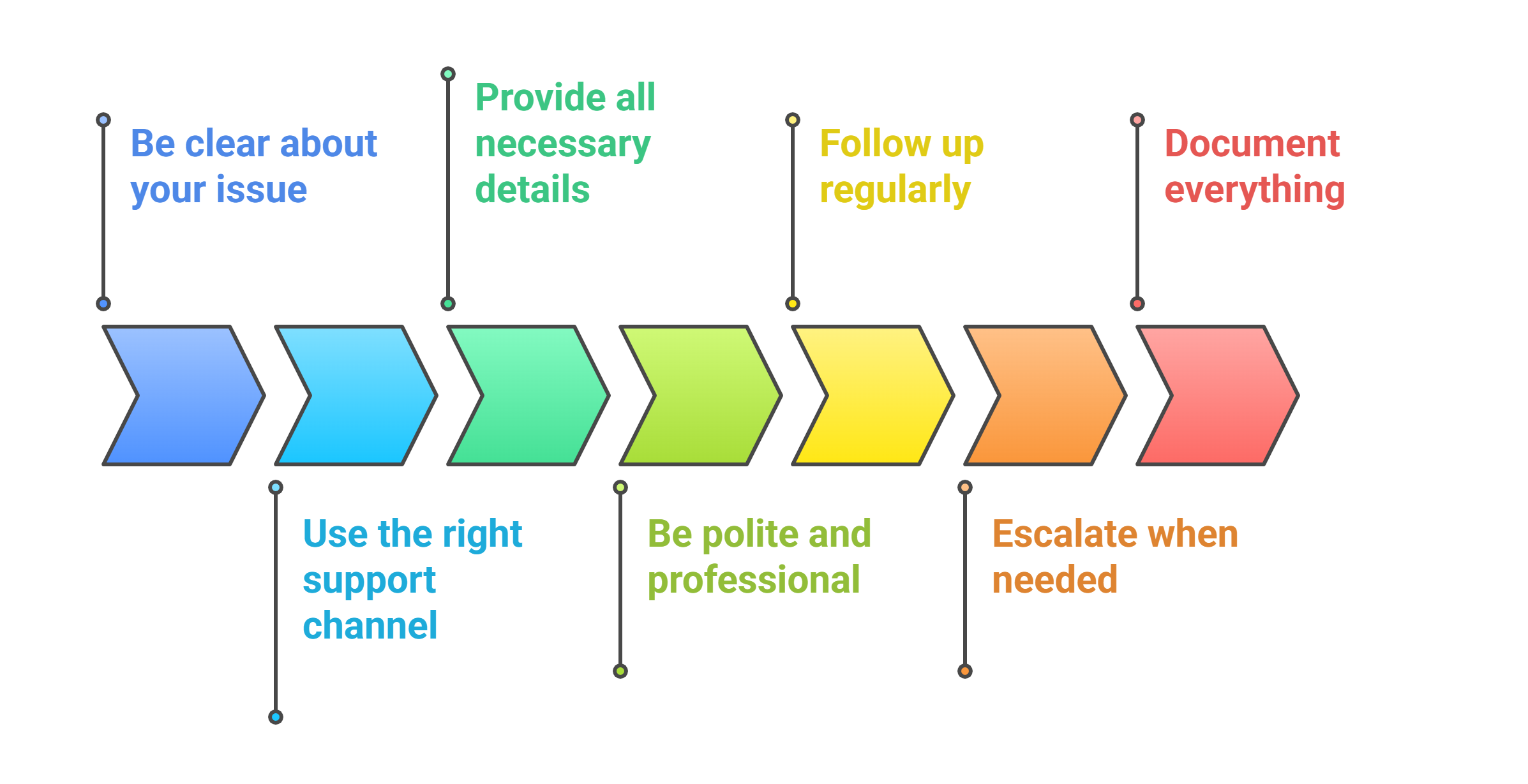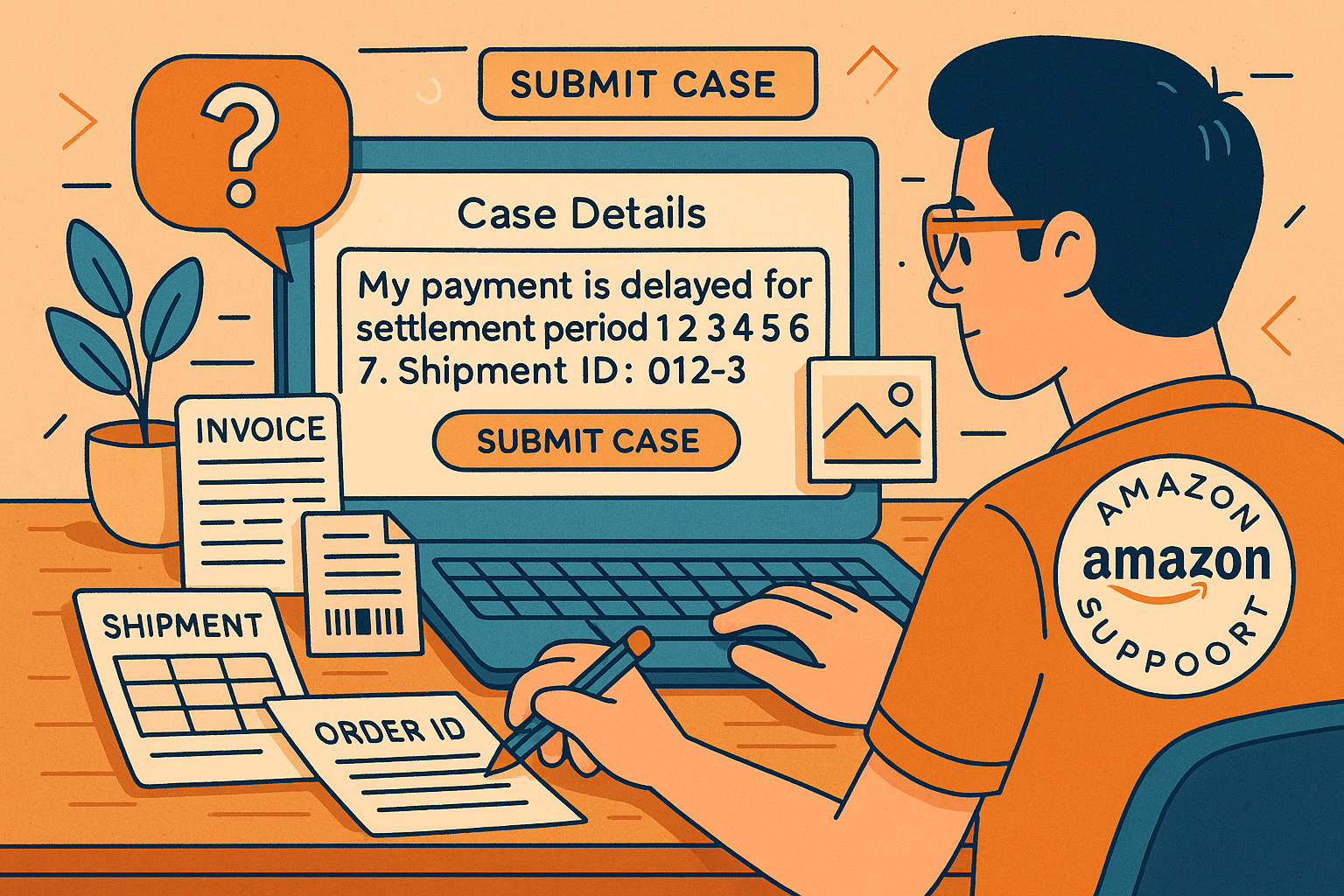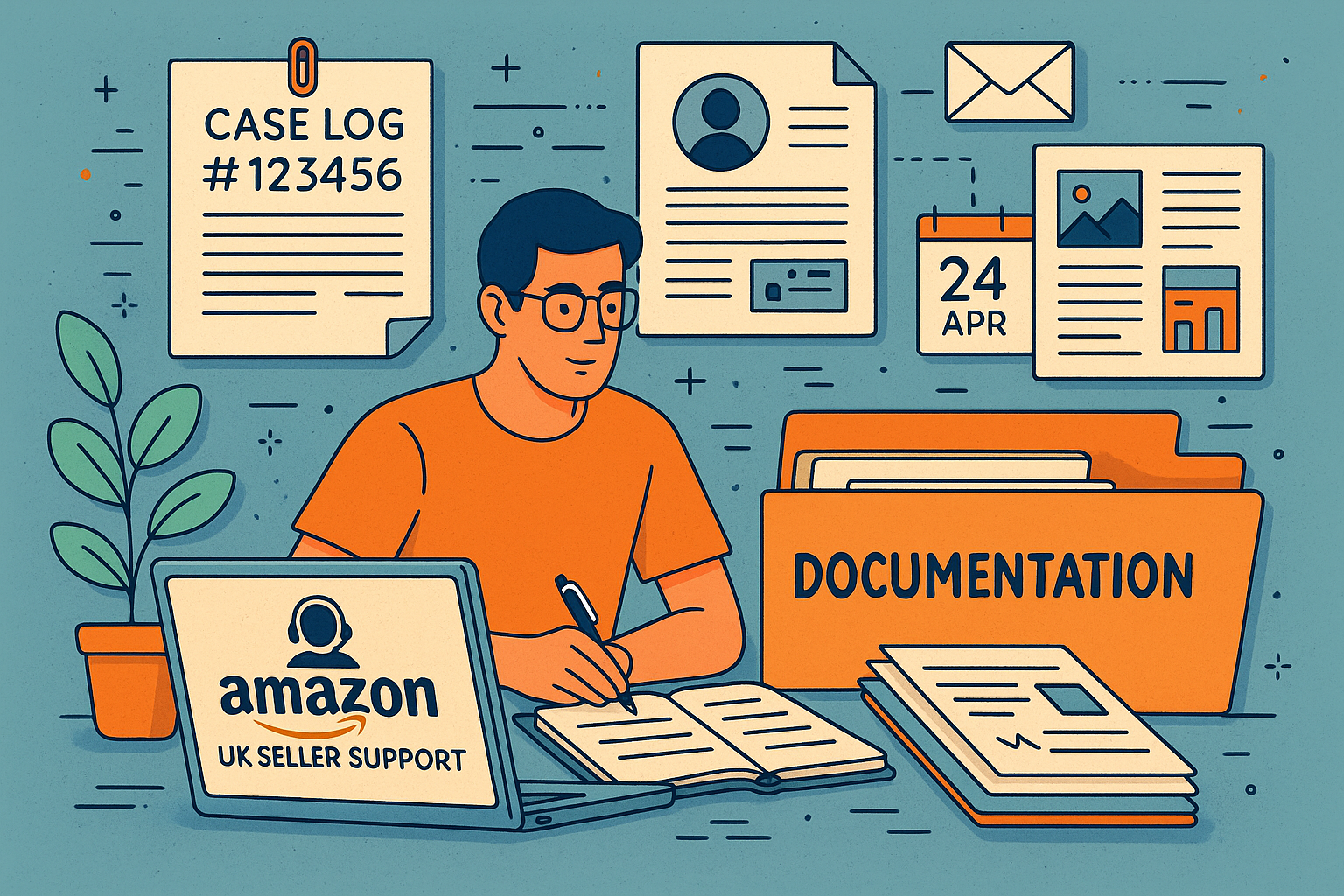TL;DR
- Clearly define your issue and include all relevant details when opening a support case.
- Choose the right Amazon Seller Support UK channel (case, phone, or chat) for faster help.
- Maintain polite, professional communication to improve response quality and cooperation.
- Follow up regularly through the Amazon case log UK to keep your issue moving forward.
- Escalate the case if needed, using proper references and clear explanations.
- Document every step, including case numbers, messages, and attachments, to protect your business and speed up resolutions.
Running an Amazon UK seller account can feel like navigating a maze — especially when something goes wrong.
Did you know that over 60% of Amazon UK sellers report delays or frustration when trying to resolve issues with seller support? From listing errors and account suspensions to delayed payouts or FBA problems, every hour spent waiting for answers can cost you sales and harm your reputation.
But here’s the good news: you can take control of the process. Understanding how Amazon seller support in the UK works is the first step to getting faster, more effective resolutions. When you know how to frame your issue, choose the right support channel, and provide the right details upfront, you dramatically increase your chances of a quick fix.
This guide walks you through the key steps to handle seller support efficiently and professionally so you spend less time chasing tickets and more time growing your Amazon business.
Understand how Amazon UK seller support works

- When you submit a case, it typically enters a queue where a support associate reviews the details and responds, usually within 12 to 24 hours.
- However, responses can vary in quality, depending on the complexity of your issue and the clarity of the information you provide.
- Support agents often rely on internal scripts and standard procedures, which means vague or incomplete cases may get general replies or delayed solutions.
- There are several ways to reach support: through the “Get Support” option in Seller Central, by phone (for urgent cases), or via live chat (when available).
- For more serious or account-level issues, Amazon may assign your case to a higher-level team, which can extend response times.
A critical point to remember is that Amazon’s system tracks all correspondence in the Amazon case log UK, meaning that clear documentation and polite, professional communication work in your favour. Providing detailed information, such as order IDs, ASINs, screenshots, and relevant timelines, helps the agent understand your problem faster.
Additionally, Seller Central offers an extensive help section and forums, which can sometimes resolve basic questions without needing to open a case. By understanding the flow of Amazon UK seller support, you can approach issues more strategically — saving time, reducing frustration, and keeping your business running smoothly.
How to deal with Amazon UK seller support: Step-by-step guide
Step 1: Be clear about your issue
When contacting Amazon UK seller support, clarity is your most valuable tool. Many sellers lose precious time because they submit vague or incomplete cases, which leads to back-and-forth communication and delays. To avoid this, take a moment to define exactly what you need help with before opening a case.
Start by writing down the core issue in one or two clear sentences.
For example, instead of saying “my order has a problem,” be specific: “Order ID 123-4567890 has been marked as delivered, but the customer reports they never received the item.” This immediately gives the support agent a clear starting point.
Next, gather all the relevant details. Include order numbers, ASINs, dates, screenshots, error messages, or policy references anything that will help the agent understand the full context without needing to ask for more. The clearer and more detailed your case submission, the faster an agent can assess it and provide a meaningful response.
Remember, support agents are trained to follow internal processes, so using precise language aligned with Amazon’s terms (like “A-to-Z claim,” “FBA reconciliation,” or “Buy Box suppression”) makes it easier for them to route your case correctly.
By preparing and presenting your issue clearly, you increase the chances of getting a fast, accurate resolution and you help ensure that your time and the agent’s time are both used efficiently. This small step can make a big difference in keeping your Amazon UK business running smoothly and helping you fix Amazon issues UK more efficiently.
Step 2: Use the right support channel
Using the right support channel is key to getting faster resolutions when dealing with Amazon seller help UK. Many sellers waste valuable time by opening cases in the wrong place or using channels that don’t fit the urgency or nature of their issue.
Amazon offers several support options, and knowing when to use each can make all the difference.
- For most common issues such as listing errors, stranded inventory, or basic FBA questions, the “Get Support” button in Seller Central is the best place to start. This allows you to open a case and track all communications in one place, ensuring there’s a clear record of your conversation.
- If your issue is time-sensitive such as a suspended listing before a major sale or a sudden account health warning, consider using phone support. You can request a callback through Seller Central, often receiving assistance faster than by waiting for a case reply.
- When available, live chat is also an excellent option for quick, straightforward questions. It’s particularly useful if you need clarification on a policy or a fast check on your account.
- For more complex problems, such as technical errors or escalations, Amazon may move your case to a specialised team. In these cases, patience is required, but starting with the right channel helps avoid unnecessary delays.
Choosing the right pathway upfront not only saves time but also increases the chances of getting your issue resolved smoothly, keeping your Amazon UK operations on track.
Step 3: Provide all necessary details
Providing all necessary details when opening a case with Amazon UK seller support is one of the most important steps to getting faster, more effective resolutions. A common mistake sellers make is sending unclear or partial requests, which can cause delays, repetitive follow-ups, or even leave the issue unresolved and the case closed without a solution.
To avoid this, always start by clearly describing the issue. Be specific — for example, instead of saying “my payment is delayed,” provide the exact settlement period, affected order IDs, and any error messages you’ve seen.
If you’re facing an FBA problem, include the shipment ID, ASINs, and tracking details. For listing issues, attach screenshots that show the error or mismatch. It’s also helpful to outline the timeline.
- When did the issue start?
- Have you already tried any troubleshooting steps?
Sharing this context can help the support agent understand the situation faster and avoid repeating actions you’ve already taken.
Attach all relevant documents, such as invoices, tracking receipts, or buyer-seller communications, if applicable. Providing these details up front reduces the need for the agent to follow up for more information, which can save days of waiting.
Finally, write in a polite, concise tone. A well-organised message with all key points included increases your chances of the case being handled by the right team quickly. Remember: the clearer and more complete your submission, the faster you can help Amazon support you.
Step 4: Be polite and professional
When dealing with Amazon UK seller support, your tone and attitude matter more than you might think. It is often overlooked, yet it can make a big difference in how quickly and effectively your issue is handled.
Remember, support agents are people too. They work under strict guidelines, handle dozens of cases daily, and are more likely to engage positively with sellers who communicate respectfully. Even if you’re frustrated or dealing with a repeated problem, avoid harsh language, blame, or sarcasm in your messages.
Instead, use clear and courteous language. Start your case with a polite greeting, clearly explain the issue, and end with a professional closing like “thank you for your help” or “I appreciate your assistance.” This sets a constructive tone and increases the chance that the agent will take the time to fully review your case.
If you need to follow up on a delayed or unresolved case, avoid angry or impatient messages. Simply reference your case ID, restate the key points, and politely request an update.
For example: “Hello, I’m following up on case #123456 regarding my FBA shipment issue. Could you please provide an update or let me know if you need additional details from my side?”
Professional, polite communication not only improves your chances of getting faster support but also leaves a positive record in your case history, which can help if you need to escalate the matter later.
Step 5: Follow up regularly
Following up regularly with Amazon UK seller support is one of the most effective ways to ensure your case moves forward and doesn’t get lost in the system. While it’s tempting to assume that once you’ve submitted a case, the team will handle it promptly, the reality is that cases can sometimes stall, especially if they require input from multiple departments or senior teams.
A smart approach is to check the status of your case within 24 to 48 hours of submission. Log in to Seller Central, navigate to your case log, and look for updates or additional requests from the support team. If you don’t see progress or if the response seems generic or incomplete, follow up with a polite message asking for clarification or escalation.
When following up, always reference your case ID and restate the key details of your issue. This helps the next agent understand the context quickly, reducing the chance of repetitive back-and-forth. Avoid submitting entirely new cases for the same issue, as this can confuse the system and delay resolutions further.
If you’re following up multiple times, remain professional and constructive. While frustration is understandable, aggressive or impatient messages rarely speed things up. Instead, showing that you are attentive and cooperative often encourages faster action.
By following up regularly and maintaining clear communication, you demonstrate to Amazon UK’s support team that you’re proactive and serious about resolving your issue, which can significantly improve your chances of a faster resolution.
Step 6: Escalate when needed

To escalate effectively, first review your existing case carefully. Have you provided all the necessary details, such as order numbers, ASINs, screenshots, or timelines? Have you clearly explained what resolution you are seeking?
If the answer is yes and you’re still not getting results, politely request escalation in your next message. You can write something like, “Thank you for your assistance so far. As this issue remains unresolved, I kindly request that this case be escalated to a senior team or specialist for further review.”
If the issue is critical — for example, an account suspension or major FBA shipment error — you may also want to open a new case and reference the previous case number, ensuring it’s directed to the correct department.
Keep in mind that escalation doesn’t guarantee instant results, but it does increase the likelihood of your case being handled by someone with the right expertise. Stay professional, patient, and firm in your communication.
Remember, the goal is to work with Amazon’s support structure, not against it, so you can resolve problems efficiently and keep your business running smoothly.
Step 7: Document everything
Documenting everything is one of the most overlooked but powerful strategies when dealing with Amazon UK seller support. Many sellers assume that once they open a case, Amazon will handle the rest — but in reality, keeping your own detailed records can save time, prevent miscommunication, and protect your business if issues escalate.
Start by keeping a record of every interaction with seller support, including case reference numbers, dates, agent names (if provided), and summaries of the responses you receive. This helps you track progress and avoid repeating information when following up or escalating a case.
For example, if you’ve already provided proof of shipment for a lost FBA item, having that case number handy ensures the next agent can quickly pick up where things left off.
Additionally, save copies of all attachments you send, such as screenshots, invoices, or correspondence. Create a simple folder system on your computer or cloud storage where you can organise these by issue type or date.
If you need to escalate a case or appeal a decision, having clear, time-stamped records strengthens your position. Amazon’s internal teams also log interactions, but their records may not always align perfectly with your experience — your own documentation provides a valuable backup.
In short, documenting everything keeps you in control. It makes your interactions with Amazon UK seller support more efficient, reduces the risk of mistakes or delays, and helps you resolve problems faster while protecting your business reputation.
Wrap up
In the fast-paced world of Amazon UK selling, knowing how to work effectively with seller support can save you time, money, and stress. By staying clear, organised, polite, and proactive, you put yourself in the best position to resolve issues quickly and keep your business running smoothly. But you don’t have to handle everything alone.
An experienced Amazon consultant can help you navigate complex support cases, escalate issues properly, and even prevent problems before they arise. With expert guidance, you’ll spend less time chasing fixes and more time focusing on growth.
If you’re ready to strengthen your Amazon operations and get faster, smarter solutions, consider partnering with a trusted Amazon consultant today — and take the next step toward a smoother, more successful seller journey.









